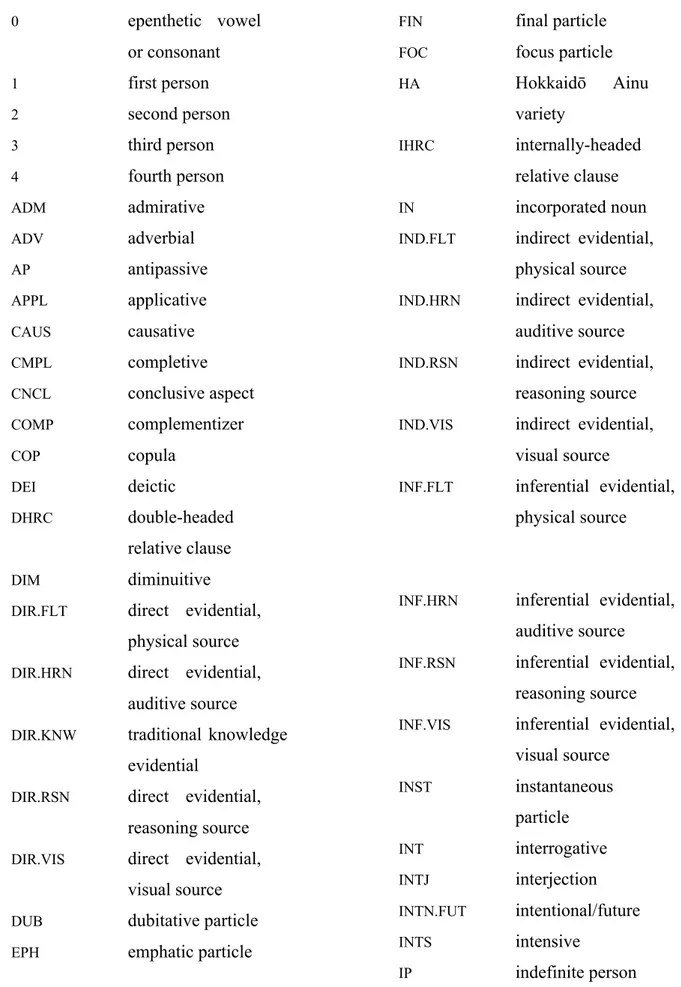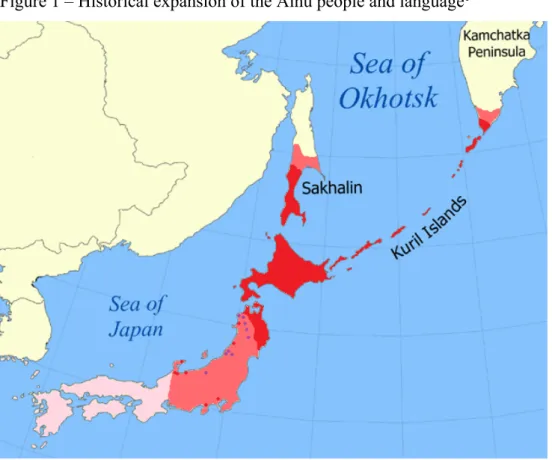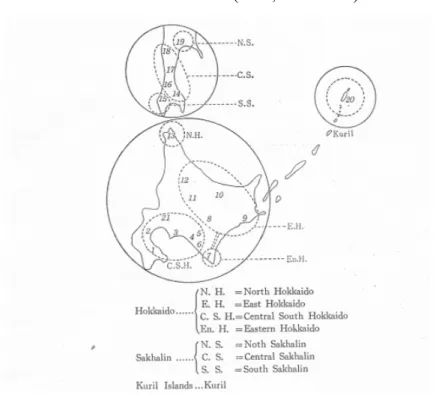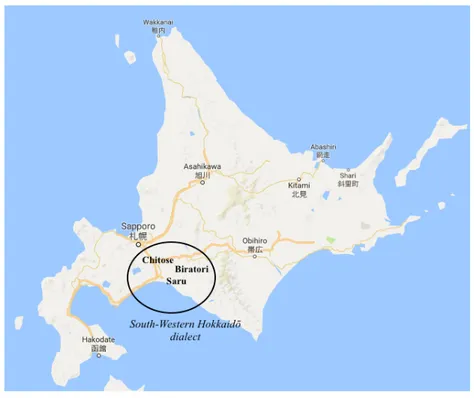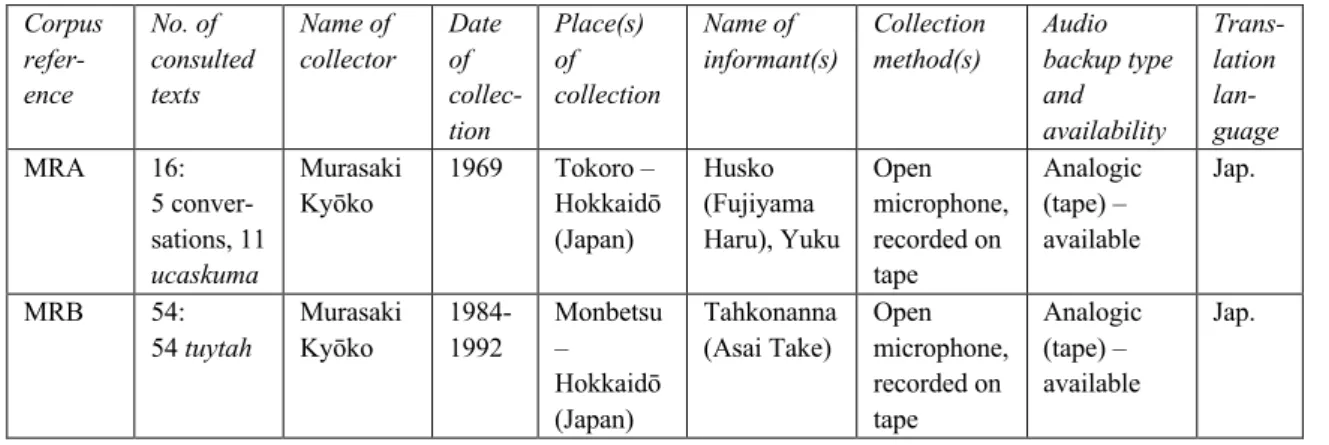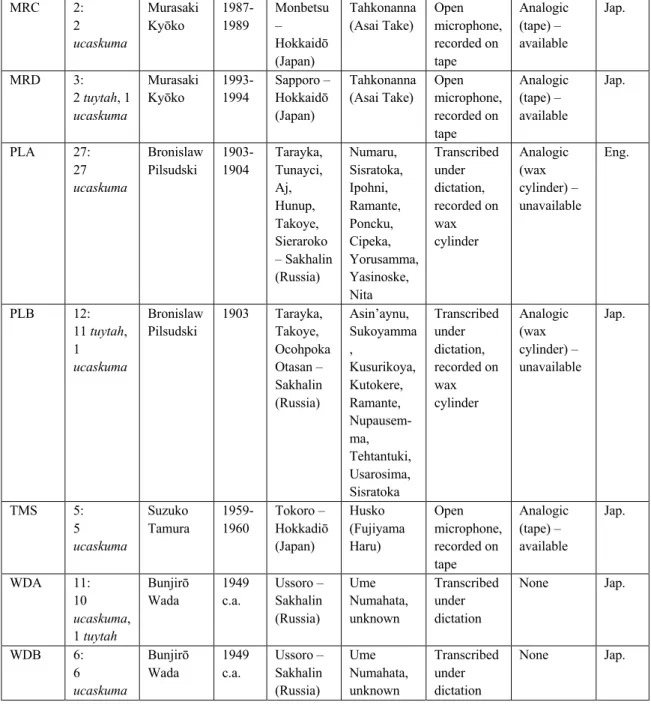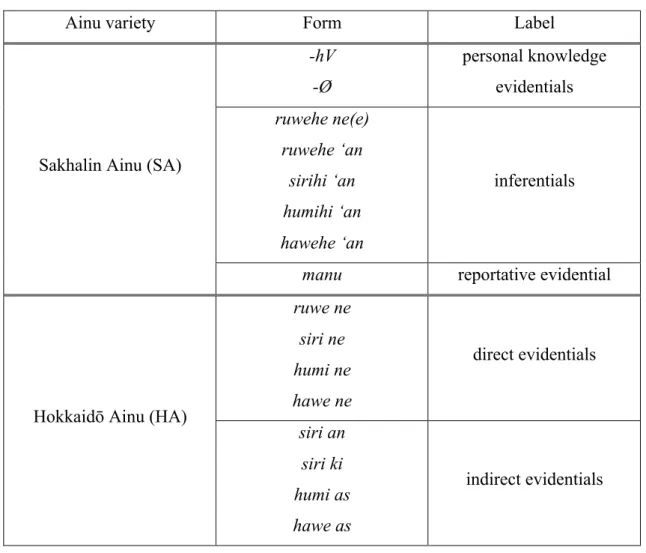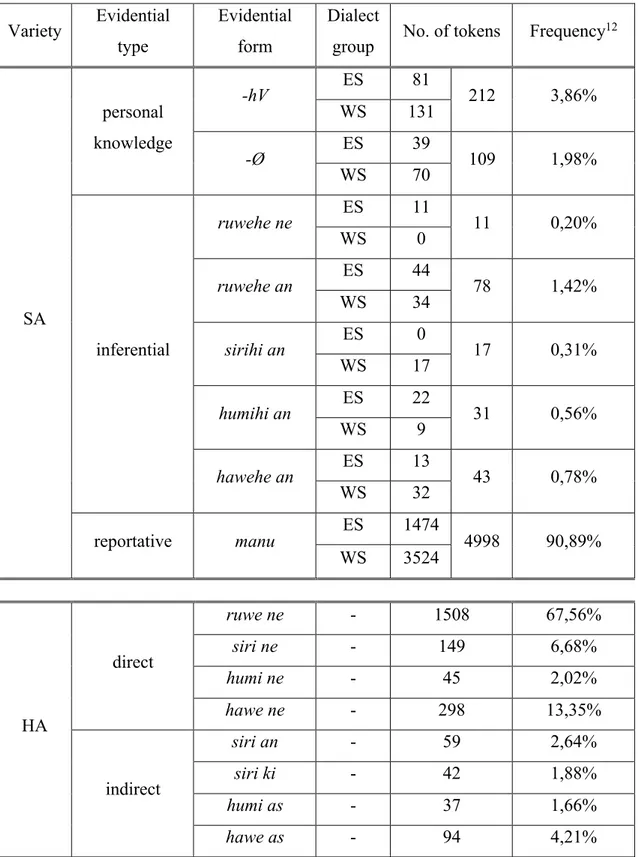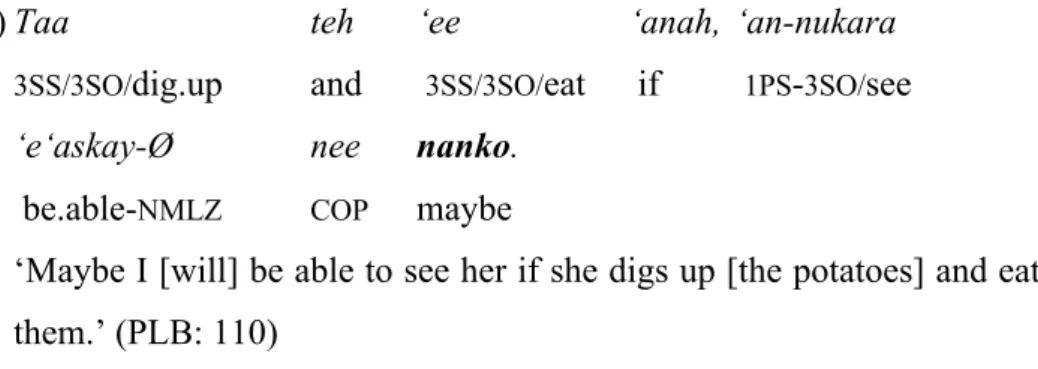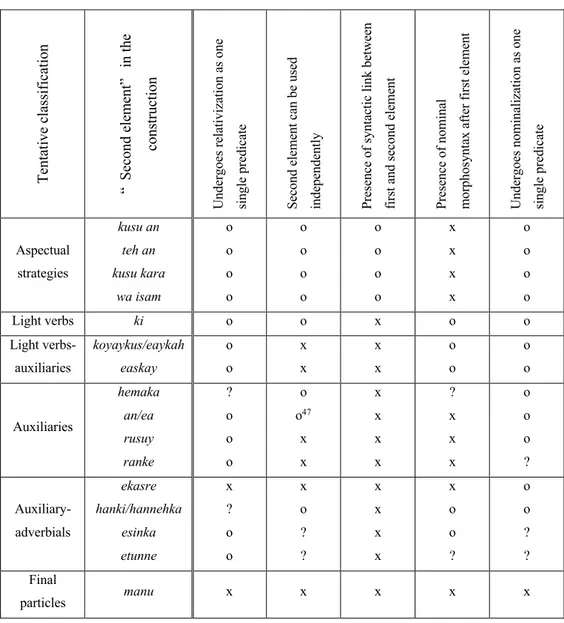Ainu Evidentiality:
A semantico-pragmatic analysis and a
morphosyntactic account
Elia Dal Corso
Thesis submitted for the degree of
Doctor of Philosophy in Linguistics
2018
Department of Linguistics
SOAS, University of London
I have read and understood Regulation 21 of the General and Admissions Regulations for students of the SOAS, University of London concerning plagiarism. I undertake that all the material presented for examination is my own work and has not been written for me, in whole or in part, by any other person. I also undertake that any quotation or paraphrase from the published or unpublished work of another person has been duly acknowledged in the work which I present for examination.
Abstract
This thesis explores the pragmatics and semantics of a number of evidential markers in Ainu, a language isolate native to the islands of the Southern Okhotsk sea; specifically, this study focuses on the Hokkaidō and Sakhalin varieties of the language. Furthermore, I provide a morphosyntactic account of the markers in question, that are non-obligatory, sentence-final markers that structurally follow a verbal constituent. The origin of all the evidential markers I take into account can be more or less safely traced back to nominal categories.
In Chapter 1, I give a profile of the Ainu language and introduce the scope and aim of the study, and the methods and language sources I employed. In Chapters 2 and 3, I introduce my theoretical framework for this study and provide a literature review of previous research on evidentiality specifically in Ainu studies. Secondly, in Chapters 4 and 5, I proceed with discussing the morphosyntax of Ainu evidentials, focusing on how they involve processes such as noun incorporation, nominalization, and relativization. Subsequently, I move to a separate analysis of evidentials in Sakhalin Ainu and Hokkaidō Ainu, and discuss their interaction with epistemic modality and mirativity, as well as their interplay with verbal aspect and mood. Ultimately, I show how separate Ainu evidentials interact with epistemic modality on different levels and how evidential markers secondarily may become indicators of verbal tense, a feature of the Ainu verb long considered to be overtly unmarked. The main outcome of the study is that evidentiality in both Ainu varieties under scrutiny is regulated, in its use and formal encoding, by source reliability. Moreover, the study highlights that only in the Hokkaidō variety evidentiality also responds to the feature of event accessibility, that is the immediateness with which the speaker accesses information.
Acknowledgements
The study presented in this thesis was funded by the Meiji Jingū Intercultural Research Institute with the Japanese Studies Research Scholarship, and by the British Association of Japanese Studies (BAJS) in two separate occasions, with the Postgraduate Studentship for International Students in the UK and with the John Crump Studentship.
Many people inside and outside the academic environment have contributed throughout the past four years to the making of this thesis, each one of them in their own special way. My first thank you goes to my supervisor, Irina Nikolaeva, for her always objective and insightful observations on my work, for her comments and advice that have been most crucial for completing my study. Thank you also to Nathan Hill and Friedrike Luepke for providing further comments and for making me notice all the little things that needed improvement. A thank you also to my two examiners, who provided further comments and suggestions during the viva to refine this thesis – Dr. Martina Faller, whose work was an inspiration for my study, and professor Kasia Jaszczolt. I would like to thank some of my PhD colleagues who, more than others, were of help and support in different ways and at different stages of my research. Charlotte Hemmings, for all the bibliographic suggestions and for being a trustworthy point of reference during the most confusing first year of my PhD; Karolina Grzech, for our discussions on evidentiality and for sharing with me her vast knowledge on the topic; Connor Youngberg and Sophie Mu, for the light-hearted chats, the coffee, and the gossips that helped lift the pressure of the drafting process. One additional thank you to Connor who has proofread this thesis for me, pointing out the little flaws and suggesting how to improve my work. Thank you also to Sheena Shah, for being an amazing colleague and for making my passion for teaching even stronger.
Other people in Japan, whom I met during my fieldwork, also deserve all my gratitude. Anna Bugaeva, for her patience, availability and endless kindness in discussing any kind of Ainu-related matter with me, for welcoming me at Rika Daigaku in Tokyo, for her support and inspiration to continue the study of the Ainu language, and for introducing me to places and people that I otherwise would have never visited and met – thank you. Kyōko Murasaki, for welcoming me in her home and sharing with me her passion for Ainu, for giving me access to language resources without which the completion of this thesis would have been much more difficult if not impossible.
Yasushige Takahashi, for introducing me to the Aynu Teetawanoankur Kampinuye Cise at Hokkaidō University and for making it possible for me to access its archives, for his tireless passion towards the study of Ainu that I have constantly admired. Hidetoshi Shiraishi, for giving me the opportunity of presenting my research at Sapporo Gakuin University and for sharing his experience about working with indigenous languages. Noriaki Aibara, for our discussions on the Ainu language and literature, and Ishihara-san and that cave of wonders that is his bookstore in Sapporo, a place I could never get tired of and that played a crucial part in the collection of Ainu language materials.
My deepest thanks go also to Dominique, Gustaaf, Agata and the whole Dundalk College. It was a pleasure sharing with you not only my PhD life, but also all the experiences, moments, memories made in London and elsewhere in what has been the warmest, liveliest and most comforting place I could hope to live in – thank you, you all really made these last three years better. A special thank you to Adelina, Sabine, Piet, and Clara for contributing to all of this.
Doing a PhD would have never been possible, for so many reasons, without my family. The biggest thank you to my Super5 – Anna, for all the laughing and crying, the smiles and tears, for your being you, and because you are always, always there for me. Thea, for the never-ending support, for your positive and humorous stance towards life that never ceases to surprise me and give me strength… and for proving that animals can make a difference! Federica, for sharing the struggle that living in London is all about always with a ready smile and for teaching me to be resilient. Agnese, for our talks, all the readings and the museums that tasted like coffee and onigiris, and for being so beautifully insightful and foolish at the same time. Alessandra G., for standing by since day one (literally!), for giving my fieldwork in Japan the flavor it was missing and for all the good times. Paolo, for your help during the sad times, for your support and honest friendship in all other situations, and for always telling it like it is, I appreciated every single word you had for me in these four years. Alessandra F. and Alessandro, for always keeping an eye, even from afar, and for proving to be best friends no matter what.
Finally, thank you to Daniele, for letting me know the wonderful person that you are, for being an ally, a friend, an inspiration, and many things more, for sharing the little
things of life with me every day; for being a most needed critical voice that helped me focus on what really mattered and at the same time for lifting me up when I was feeling defeated. Thank you to all my uncles, aunts, and cousins, but especially thank you to my grandmothers who always were my biggest supporters and who didn’t get to see the end of what they had known all along would have been a fruitful journey – I know they would be proud.
Last but not least, thank you to my mom and dad, for never giving up even when I myself was about to, for never getting tired of pushing me to be at my best and never stopping dreaming with me, and for teaching me what being a family really means. This is for you.
Table of Contents
Abstract………...……… p. 3 Acknowledgements………. p. 4 Table of Contents……… p. 7 List of Figures………... p. 15 List of Tables………. p. 15 List of abbreviations………. p. 16 Chapter 1 – Introduction………………. p. 18 1.1 Topic of this dissertation……….. p. 181.1.1 Scope of the study 1.1.2 Aim of the study
1.2 A profile of the Ainu language……… p. 27 1.2.1 Genetic relations and general linguistic features
1.2.2 Dialectal subdivision
1.3 Reasons for a corpus-based study……… p. 33 1.3.1 Unfeasibility of elicitation
1.3.2 Compensating for the lack of elicitation
1.4 Quantitative and qualitative analysis………... p. 37
1.5 The reference sources……….. p. 38
1.6 Metadata………... p. 40
1.7 Conventions………. p. 43
1.8 Synopsis of the chapters………... p. 44 Chapter 2 – Evidentiality Cross-linguistically………... p. 45 2.1 Content of the chapter……….. p. 45 2.2 Evidentiality cross-linguistically………. p. 45
2.2.1 Evidentiality as a linguistic category 2.2.1.1 Classification of evidentials 2.2.1.2 Speaker’s perspective
2.2.1.3 Assimilation of information and personal knowledge 2.2.2 Epistemic modality
2.2.2.1 Mirativity and first person 2.2.3 Evidentiality and TAM categories
2.2.4 Terminology
2.3 Summary……….. p. 68 Chapter 3 – Evidentiality in Ainu………... p. 70 3.1 Content of the chapter……….. p. 70
3.2 Ainu evidentials………... p. 70
3.2.1 Formal devices encoding evidentiality and their subdivision 3.2.2 Distribution
3.2.3 Historical development
3.2.3.1 The origin of SA personal knowledge evidentials -hV and -Ø 3.2.3.2 Sensorial nouns as the basis of evidentiality
3.2.3.3 Possible origins of manu
3.3 Previous research on Ainu evidentiality and evidential forms……… p. 77 3.3.1 Evidentiality in Ainu studies
3.3.2 Accounts of personal knowledge evidential forms 3.3.3 Accounts on inferential forms of SA
3.3.4 Accounts on direct and indirect evidentials of HA 3.3.5 Accounts on the reportative manu
3.4 Morphosyntactic processes and evidentiality – previous research on Ainu… p. 85 3.4.1 Possessive constructions
3.4.2 Relative clauses and noun-complement constructions 3.4.3 Noun incorporation – arguments and functions 3.4.4 Clause nominalization
3.5 Observations on Ainu evidentials’ structure……… p. 96 3.5.1 Noun incorporation – inconsistency within the evidential domain
3.5.2 Indirect evidentials and relativization 3.5.3 Nominalization
3.6 Summary and grounding for the analysis………..… p. 103 Chapter 4 – Background Assumptions on Morphosyntax……………. p. 105 4.1 Content of the chapter……….... p. 105 4.2 Relative clauses – internally-headed and double-headed……….. p. 105
4.2.1 Internally-headed relative clauses (IHRCs)
4.2.2 Double-headed relative clauses (DHRCs) and correlatives
4.3.1 Noun incorporation proper (NI) 4.3.2 Pseudo-noun incorporation (PNI)
4.4 Nominalization and mixed categories……… p. 119 4.4.1 Types of nominalization
4.4.2 Markedness of nominalization 4.4.3 Mixed categories
4.5 Insubordination..……… p. 123 4.6 Summary……… p. 125 Chapter 5 – Morphosyntax of Ainu Evidential Forms…………... p. 126 5.1 Content of the chapter……… p. 126 5.2 Personal knowledge evidentials of SA……… p. 126
5.2.1 Morphophonology of personal knowledge evidentials 5.2.1.1 The -hV form
5.2.1.2 The -Ø form
5.2.2 Syntax of personal knowledge evidentials 5.2.2.1 Nominalization and biclausality 5.2.2.2 Biclausality and the copula ne(e) 5.2.2.3 Asemantic transposition
5.2.2.4 The emergence of insubordination
5.2.2.5 Evidence for the presence of Ø-nominalization
5.2.2.6 Concluding remarks on the syntax of personal knowledge evidentials 5.3 HA direct evidentials………. p. 139
5.3.1 Morphophonology of direct forms 5.3.1.1 Phonological wordhood
5.3.1.2 Possessive morphology in direct evidentials 5.3.2 Morphosyntax of direct forms
5.3.2.1 The ne – an alternation
5.3.2.2 Direct evidentials as mixed category constructions
5.4 SA inferentials………... p. 147 5.4.1 Morphophonology of inferentiality
5.4.2 Morphosyntax of inferentiality 5.4.2.1 Inferentials and embedding 5.4.2.2 A case of PNI
5.4.3 Concluding remarks on SA inferentials
5.5 HA indirect evidentials……….. p. 156 5.5.1 Morphophonology of indirect forms
5.5.2 Morphosyntax of indirect forms 5.5.2.1 Possessive constructions and PNI 5.5.2.2 NI and biclausality
5.5.2.3 Classificatory NI in SPCs
5.5.2.4 Incorporation and relative clauses
5.5.3 Concluding remarks on HA indirect evidentials
5.6 Reportative manu………... p. 176 5.6.1 Observations on morphology
5.6.2 Syntactic status of manu
5.6.2.1 “Auxiliary constructions” of SA 5.6.2.2 Syntactic tests for manu
5.6.2.3 Explanation of the categorization of “auxiliary constructions” 5.6.2.4 Manu as a final particle
5.7 Summary……… p. 187 Chapter 6 – Background Assumptions on Semantics and
Information Theory……………….. p. 189 6.1 Content of the chapter……… p. 189 6.2 Grounding for the analysis………. p. 189 6.3 Discourse analysis……….. p. 191
6.3.1 Discourse and interpersonal relations 6.3.2 Topicality and givenness
6.3.3 Textual parsing
6.4 Sense hierarchy……….. p. 198 6.5 Deixis………. p. 200 6.6 Territory of information………. p. 203
6.6.1 Basic notions
6.6.2 TI revised – relevant concepts for Ainu 6.6.3 A model of TI for Ainu
6.6.3.1 TI layout – subdivision and elements 6.6.3.2 Knowing and having information 6.6.3.3 Epistemic tone and evidential tone
6.6.3.4 Evidentiality – access to the event
6.6.3.5 Evidentiality – selection of the most reliable source 6.6.3.6 EP and EV calculation
6.7 TAM categories………. p. 223 6.7.1 Modality
6.7.2 Telicity and event decomposition 6.7.3 Tense reference
6.7.4 Perfectivity and event perspective
6.7.5 TAM categories in previous Ainu studies 6.7.6 TAM categories and the TI
6.7.6.1 From TI to RTT
6.7.6.2 Points in time of the RTT
6.7.6.3 Modality and perfectivity in the TI
6.8 Summary……… p. 235 Chapter 7 – Sakhalin Ainu Evidentials……… p. 236 7.1 Content of the chapter……… p. 236 7.2 Personal knowledge evidentiality……….. p. 236
7.2.1 Basic assumptions for personal knowledge evidentiality 7.2.2 Distribution of -hV and -Ø forms
7.2.2.1 Co-occurrence with conceptual categories 7.2.2.2 Epistemic overtones
7.2.2.3 Summary of problems and proposal for the analysis 7.2.3 Epistemic tone
7.2.3.1 Event perspective and elements within the TI 7.2.3.2 Calculation of epistemic tone
7.2.4 Evidential tone
7.2.4.1 S and t within the TI 7.2.4.2 External-S
7.2.4.3 Calculation of evidential tone 7.2.4.4 Mirative and emphatic expressions 7.2.5 Overall personal knowledge tone
7.2.6 Summary of the use of personal knowledge evidentiality 7.2.7 Personal knowledge evidentiality beyond information source
7.2.8 Aspectuals and dubitative expressions explained 7.2.8.1 The use of the aspectual ‘an
7.2.8.2 The use of nanko(o) 7.2.9 Concluding remarks
7.3 Evidence through inference………... p. 272 7.3.1 The choice of inferential forms
7.3.2 Internal semantics of inferentials 7.3.3 Sense hierarchy
7.3.4 Perception and processing of sensorial stimuli 7.3.4.1 Sight-related inferentials
7.3.4.2 Non-sight-related inferentials 7.3.4.3 Sensorial saliency
7.3.5 Event perspective and telicity: the case of ruwehe ne(e) and hawehe ‘an 7.3.5.1 Event perspective
7.3.5.2 Predicate telicity 7.3.6 Summary of inferentiality
7.3.7 Inferentiality beyond information source 7.3.8 Ontological status of the source
7.3.9 Relative tense derivation 7.3.9.1 Application of RTT 7.3.9.2 Deriving relative tense 7.3.10 Summary
7.4 Reportative evidentiality……… p. 295 7.4.1 Reportative proper – hearsay and quotative
7.4.2 Reportative as traditional knowledge
7.4.3 Traditional knowledge manu as an areal feature
7.5 Double evidentiality………... p. 300 7.6 Remaining issues – scarcity of tokens and predicate telicity………. p. 302 7.7 SA evidential system……….. p. 303 Chapter 8 – Hokkaidō Ainu Evidentials……….. p. 304 8.1 Content of the chapter……… p. 304 8.2 HA evidentials – an overview on semantics, pragmatics, and functions…... p. 304
8.2.1 Nominal constituents 8.2.2 Verbal constituents
8.2.3 Poly-functionality of evidential forms
8.2.3.1 Dependent predication SPPs as aspectuals 8.2.3.2 Independent predication SPPs as lexical verbs
8.3 Direct evidentiality………. p. 319 8.3.1 Sight-related direct evidentials
8.3.2 Non-sight-related direct evidentials
8.3.3 The copula ne as marker of internal event perspective 8.3.4 Summary of HA direct forms
8.4 Indirect evidentiality……….. p. 325 8.4.1 The difference between siri an and siri ki
8.4.2 Humi as and hawe as – between inferentiality and reportative 8.4.2.1 Semantico-pragmatic differences of humi as and hawe as 8.4.2.2 Hawe as as a reportative
8.4.2.3 Summary of HA indirect forms
8.5 Double evidentiality………... p. 331
8.6 Remaining issues………... p. 333
8.6.1 Double evidentiality and clause dependencies
8.6.2 Unapplicability of the Theory of Territory of Information
8.7 HA evidential system………. p. 337 Chapter 9 – Conclusions……… p. 339 9.1 Content of the chapter……… p. 339 9.2 A summary of SA and HA evidential systems……….. p. 339
9.2.1 Similarities and differences between SA and HA evidentials 9.2.2 Typological discrepancies
9.3 Implications for Ainu studies………. p. 342 9.4 Typological and theoretical approach……… p. 343 9.5 Some unsolved issues……… p. 346 Appendix………. p. 348 I. Additional figures………. p. 348
II. Additional tables………. p. 353
III. Ainu texts………... p. 354 1. Ohacisuye – The empty-house-devil………... p. 354 2. Seta Ansamihi – I married a dog………………. p. 363
3. Sine Mahpooho – A daughter……….. p. 366 4. ‘Icarun ‘ahci – The old woman of ‘Icara……… p. 390 5. Ukoysoytak – Conversation………. p. 400 6. Penanpe an Pananpe an – Penanpe and Pananpe………... p. 415 Bibliography……… p. 419
List of Figures
Figure 1 – Historical expansion of the Ainu people and language (§1.2.1) Figure 2 – Asai’s dialectal classification (§1.2.2)
Figure 3 – Proposed dialectal subdivision for Hokkaidō Ainu (§1.2.2) Figure 4 – Proposed dialectal subdivision for Sakhalin Ainu (§1.2.2) Figure 5 – Externality in Ainu (§2.2.1.2)
Figure 6 – Externality in Squartini’s analysis (§2.2.1.2) Figure 7 – Ainu TI’s layout (§6.6.3.1)
Figure 8 – Two domains of Ainu TI (§6.6.3.1)
Figure 9 – Elements in the TI, example (178) (§6.6.3.1)
Figure 10 – Elements in the TI with values, example (178) (§6.6.3.3) Figure 11 – TI for example (192), positioning of I (§7.2.3.1)
Figure 12 – TI for example (193), positioning of I (§7.2.3.1) Figure 13 – Complete TI for example (192) (§7.2.3.1) Figure 14 – Complete TI for example (193) (§7.2.3.1)
List of Tables
Table 1 – Sakhalin Ainu reference corpora (§1.6) Table 2 – Hokkaidō Ainu reference corpora (§1.6) Table 3 – Ainu evidential forms (§3.2.1)Table 4 – Distribution of evidential forms (§3.2.2) Table 5 – Acceptability of zero nominalization (§5.2.2.3) Table 6 – Results of the syntactic tests for manu (§5.6.2.2) Table 7 – Having and knowing information (§6.6.3.2)
Table 8 – Criteria met by S and t and results of the selection process (§6.6.3.5) Table 9 – Reichenbach’s E, R and S relations (§6.7.3)
Table 10 – S, R, E relations and relative tense (§7.2.7.1)
Table 11 – Semantic and functional stimuli of inferentials (§7.3.2) Table 12 – Organization of inferential forms (§7.3.4.3)
Table 13 – Derivation of reference tense (§7.3.9.2) Table 14 – Organization of SA evidentials (§7.7)
Table 15 – Semantic and functional stimuli of HA evidentials (§8.2.1) Table 16 – Organization of direct forms (§8.3.4)
Table 18 – Organization of HA evidentials (§8.7)
List of abbreviations
0 epenthetic vowel or consonant 1 first person 2 second person 3 third person 4 fourth person ADM admirative ADV adverbial AP antipassive APPL applicative CAUS causative CMPL completive CNCL conclusive aspect COMP complementizer COP copula DEI deictic DHRC double-headed relative clause DIM diminuitiveDIR.FLT direct evidential, physical source DIR.HRN direct evidential,
auditive source DIR.KNW traditional knowledge
evidential
DIR.RSN direct evidential,
reasoning source
DIR.VIS direct evidential, visual source DUB dubitative particle
EPH emphatic particle
FIN final particle
FOC focus particle
HA Hokkaidō Ainu
variety
IHRC internally-headed relative clause
IN incorporated noun
IND.FLT indirect evidential, physical source IND.HRN indirect evidential,
auditive source IND.RSN indirect evidential,
reasoning source IND.VIS indirect evidential,
visual source
INF.FLT inferential evidential, physical source
INF.HRN inferential evidential, auditive source INF.RSN inferential evidential,
reasoning source INF.VIS inferential evidential,
visual source INST instantaneous particle INT interrogative INTJ interjection INTN.FUT intentional/future INTS intensive IP indefinite person
ITR iterative NCLF numeral classifier ND narrative deixis NEG negative NI noun incorporation NMLZ nominalizer
ONOM onomatopoeic word
PASS passive PC paucal PIN pseudo-incorporated noun PK personal knowledge evidential
PKE personal knowledge evidentiality
PL plural
PNI pseudo-noun
incorporation
PO plural object
POI pluralindirect object
POSS possessive PRG progressive aspect PRF perfective aspect PSRS passive resultative PS plural subject REC reciprocal REF reflexive REP reportative RH relative head RSLT resultative aspect SA Sakhalin Ainu variety
SD social deixis
SVL subject in light verb
construction
SO singular object
SOI singularindirect object SPC sensorial perception construction SPP sensorial perception predicate SS singular subject TI territory of information TR transitivizer
VO object verb in light
Chapter 1
Introduction
1.1 Topic of this dissertationThe topic of this dissertation is the linguistic category of evidentiality. Throughout the following chapters, I will consider the properties, limitations, and implications of this category for the case of Ainu, an indigenous language native to the islands of the Southern Okhotsk Sea, that constitutes the target of my study.
In linguistics, evidentiality has to do with source of information or how information is acquired by a speaker (Aikhenvald, 2004). When using evidentiality in a language, a speaker is ideally providing an answer to the two following questions:
- Where has she obtained the information she is transmitting from? - What was the physical or non-physical channel that allowed the
acquisition of this information?
The following example from Foe, a Papua-New-Guinean language unrelated to Ainu, serves as an illustration of how evidentiality can simultaneously encode the answer to these two questions.
(1) Aiya bare wa-boba‘ae.
plane come-EV.VIS
‘An airplane is coming (I can see it).’ (Rule, 1977: 71-4 in Aikhenvald, 2004: 62)
The form boba‘ae in (1) is the linguistic device dedicated in the Foe language to encode direct visual evidentiality. From this form, we understand both that the speaker has direct evidence (which he/she acquired first-hand) for her statement, and that this evidence was acquired through sight.
The specificity with which evidentiality can be said to answer to the aforementioned two questions varies sharply cross-linguistically. Evidential systems in languages, in fact, may provide indications on information source and on the channel of information acquisition more or less thoroughly. The higher or lower specificity is normally mirrored in the wider or narrower range of formal realizations taken by
evidentiality in a language – each separate formal realization encodes a specific conceptual domain of evidentiality, that differs from others exactly in terms of the kind of source and/or the means of acquisition it subsumes (see §2.2).
1.1.1 Scope of the study
In setting the scope of my analysis on Ainu, I selected, from among the varieties and dialects of the language, those to be included as desirable targets for an examination of evidentiality. The parameters for this selection were mostly the vitality status of Ainu varieties and dialects, and the quality and quantity of language documentation that has been conducted in the past. These two issues (that I better address in §1.3) eventually brought me to focus on two of the main varieties of the language – Sakhalin Ainu (henceforth SA) and Hokkaidō Ainu (henceforth HA). Within these two varieties, I selected those sub-varieties, or dialect groups, for which a considerable amount of documentation is presently available – Eastern Sakhalin, Western Sakhalin, and South-Western Hokkaidō.
Evidentials take similar formal realizations among these dialectal groups, with the most striking differences noticeable between the Hokkaidō and Sakhalin varieties. The evidential forms under scrutiny in this dissertation are summarized in the following list. In brackets I specify whether the form(s) is found in the Hokkaidō (HA) or Sakhalin variety (SA). For the morphophonetic allophorms of these forms, some of which appear in examples (2)-(17) below, I refer the reader to Chapter 5.
a) -hV, -Ø (SA) b) ruwe ne (HA)
c) siri ne, humi ne, hawe ne (HA)
d) ruwehe ne, ruwehe ‘an, sirihi ‘an, humihi ‘an, hawehe ‘an (SA); siri
‘an, siri ki, humi as (HA)
e) hawe as (HA); manu (SA)
Forms in a) are used when the speaker has direct evidence for her statement coming from prepossessed knowledge (see §7.2).
(2) Tah kahkemah ‘an-seturi-hi ka siru-siru-hu.
that young.woman 1P-back-POSS even 3SS/3SO/rub-rub-DIR ‘That young woman rubbed and rubbed my back as well.’ (MRA: 70)
(3) Ećitom óxkajo tarap ekorō!
Ecitom ohkayo, tarap e-koroo-Ø?
Ecitom young.man strap 2SS-3SO/have-DIR ‘Young man of Ecitom, have you got a strap?’ (PLA: 114)
The form in b) indicates that the speaker has direct evidence for her statement which is based on reasoning or personal knowledge (see §8.3).
(4) Tane anakne yuk cikoykip kamuy cikoykip
now TOP deer animal bear animal
kap-uhu poronno cise esik kane (ne)
3/skin-POSS a.lot house be.full ADV
a-sat-ke wa a-kor ruwe ne korka, …
4S-3PO/be.dry-CAUS and 4S-3PO/have DIR.RSN but
‘Now the house is full of many skins of deers and bears, I dried and kept them but…’ (NKG: 228)
Point c) includes forms used when the speaker has direct evidence for her statement coming from a sensorial source (see §8.3).
(5) Sinuma ka ko-ray-niwkes siri ne
he even APPL-3SS/3SO/die-be.difficult DIR.VIS
noyne iki a.
as.if do PRF
‘It was like he too could not [separate from me].’ (KAY: 19-5,13)
(6) Usa sisakpe a-i-y-e-re humi ne ya…
be.various delicious.food 4S-4O-0-eat-CAUS DIR.FLT INT ‘Whether I was given various delicious foods…’ (TMA: 42)
(7) Sermak-a a-kor haw-as hawe ne.
protective.god-POSS 4S-3SO/have IND.HRN DIR.HRN ‘It seems I indeed had a protective god.’ (KAY: 2-6,14)
Forms in d) are used when the speaker makes an inference based on a sensorial evidence (see §7.3 and §8.4).
(8) Pon náj oxta ifuráje rúhe né.
Pon nay ohta i-huraye ruhe ne.
3SS/be.small river place+in 1PL.OBJ-3SS/wash INF.RSN ‘She washed me in a small river.’ (PLA: 227)
(9) A-nukara manu ike, sino anahne inumpe
1PS-3SO/look DIR.KNW and really EMP silver.colored
ipe ne ruwehe ‘an manu.
food COP INF.RSN DIR.KNW
‘When I looked, it really was a silverfish.’ (PLA: 195)
(10) Tuhso neeno ‘an puy ahun sirihi ‘an manu.
cave as.if 3SS/exist.PC hole 3SS/enter.PC INF.VIS DIR.KNW ‘It seemed a hole like a cave opened [but it could have been something else]’ (MRA: 95)
(11) Útara tēkoro tóxśeno húmhi am manu.
Utara teekoro tohseno humihi ‘an manu.
people really 3PS/sleep.deeply INF.FLT DIR.KNW ‘It seemed [those] people were really sleeping deeply.’ (PLA: 184)
(12) Reekoh etooro-hci ‘ani mokoro hawehe-hcin ‘an
really snore-3PS while 3PS/sleep INF.HRN<PL>INF.HRN
manu.
DIR.KNW
(13) Pet put an noyne siran wa …
river mouth 3SS/exist.PC as.if IND.RSN and
‘It seemed like there was the mouth of the river.’ (BUG: 319)
(14) Ukuran ka yaanipo isam anki sirki.
be.evening even almost 3SS/not.be about IND.VIS ‘Even in the evening it seemed he was almost about to die.’ (TMA: 14)
(15) Hinak-un maw-ko-hopunpa-an humi ne humi as.
where-to wind-APPL-fly.PL-4S DIR.FLT IND.FLT
‘It seemed indeed we were swept away to somewhere by a wind’ (KAY: 2-4,9)
Evidentials in e) are used when the speaker learns an information from somebody else through verbal report (see §7.4 and §8.4).
(16) Toop oyak-ke-ta ray pe aynu ne
there.afar other.place-POSS-in 3PS/die NMLZ person COP
sekor haw-as [h]i a-nu p ne kusu, …
ADV IND.HRN NMLZ 4S-3SO/hear NMLZ COP because
‘Because I heard that they say that the ones that die [and go] to a far-away place are people, …’ (NKB: 87)
(17) Koro kun mah ‘isam manu.
3SS/3SO/have obligation(?) woman 3SS/not.be REP ‘[They say] he has no wife.’ (MRA: 84)
Other than setting a limited scope with regards to my approach to Ainu and to the resources on the language, I also take specific stances in my consideration of evidentiality as a linguistic category. These stances eventually shape the framework I adopt in my analysis and are motivated by the characteristics and properties of information source in Ainu. My approach to information source starts from the typological generalization presented in the opening of this section – that is, evidentiality deals with source of information and with how information is acquired by a speaker.
In light of the heterogeneity shown by languages with regards to exactly the degree of specificity in which the kind of source and the means of acquisition of information are expressed, Willett (1988) and later Aikhenvald (2004) operate a cross-linguistic comparison and propose a first typological classification of evidential systems. Despite the vast variation range we witness cross-linguistically, there seems to be the typological tendency to clarify the source of information (direct or indirect) more than the channel through which the acquisition happens. The way of information acquisition, in fact, is not necessarily a salient conceptual feature definining evidentiality in all languages. In the evidential system of such languages thus the channel of acquisition is formally left underspecified or completely unspecified (Aikhenvald, 2004: 65).
One other point of variation among languages that display evidentiality is in the grammatical devices employed for its formal realization. Typologically evidentiality shows great differences with regards to its paradigmatic features and, more generally, its unitarity as a category. Along with cases where information source is marked via specialized morphosyntax, Aikhenvald (2004: 80-2) reports several cases where the encoding of evidentiality is “scattered” across the language – that is, evidentiality is encoded by categories or morphosyntactic devices that do not have information source as their primary meaning. In such languages, evidentiality cannot be said to form one unitary grammatical category. Grammaticality and the retrievability of a paradigm have traditionally been adopted in many studies on evidentiality as a divide to discuss the different formal realizations of this category that are present in a language. Studies like Arakaki (2013) follow the grammatical vs. non-grammatical subdivision of evidentiality proposed by Aikhenvald (2004), and focus on a limited number of grammaticalized forms used to mark information source (in Arakaki’s case, in Luchuan Ryukyuan). Broader approches like Squartini (2008), on the other hand, advocate for the usefulness of including less- or non-grammaticalized expressions of evidentiality, as these may be beneficial for the correct understanding of the whole category in a language – in his case, French and Italian.
The approach I take in this dissertation resembles Squartini’s in that it does not strictly limit itself to considering full grammaticality as a parameter for the analysis of those Ainu forms that express information source. However, I had to narrow the scope of my analysis for the sake of its cohesiveness so that some expressions, which nonetheless are capable to encode source of information, are not included in the present
study. Besides not systematically featuring an evidential meaning, such expressions seem to show hardly any sign of grammaticalization, but rather all morphosyntactic components involved in such expressions retain the grammatical properties they have when employed in a non-evidential function. Most notable examples are expressions like SA nah ye(e) ‘to say that’ employed to mark quotative reportative.
(18) “Ē, ájnu án” náx jé manu.
“Ee, aynu an” nah ye manu.
Yes person 3SS/exist.PC COMP 3SS/3SO/say DIR.KNW ‘Yes, [I] am a human being’ said [the demon].’ (PLA: 100)
Here the complementizer nah ‘that’ does not have a grammatically different function from the one it has when it is used, for instance, to introduce a clause not governed by a verb of saying (see nah followed by ramu ‘to think’ in (19)). Similarly, the verb ye(e) ‘to say’ has the same function of two-place verb when it indicates an action of ‘saying’ in a non-reportative environment as in (20).
(19) “Temana neera‘an ‘an-kara ‘an-kii-hi nee
how such 1PS-3SO/make 1PS-3SO/do-DIR COP
nanko” nah ramu.
maybe COMP 3SS/3SO/think
‘She thought: “How should I do?”’ (MRA: 25)
(20) Tu pírika áśpe ihékota jé.
Tu pirika as[i] pe i-hekota ye.
two be.good EPH thing 1SO-towards 3SS/3SO/say ‘He said to me some good things.’ (PLA: 119)
In contrast, the other forms that I do include in this study (listed in points a)-e) above), although they may not encode source of information in all environments where they are used, systematically show signs of grammaticalization. As an example, I take the HA direct evidential ruwe ne in (21). This evidential has historically developed from an erstwhile noun+copula construction (see §5.3). Here the nominal constituent of the evidential form (i.e. ruwe ‘the trace of’) is argued to have undergone grammaticalization
in that it does not allow other modifiers (like demonstratives or determiners) in addition to the preceding clause – that is, it does not function as full-fledged noun anymore. This is what distinguishes ruwe from non-grammaticalized nouns in the position of head of a relative clause, like menoko ‘young woman’ in (22), which in contrast do allow modifiers, here the modifying qualitative verb pirka ‘be beautiful’ (Bugaeva, 2013: 671).
(21) Eci-ekanok kusu ek-an ruwe ne.
1SS>2SO-meet to come.PC-4S DIR.RSN ‘I came to meet you.’ (BUG: 126)
(22) Kamuy ipor cannoyekar pirka
god appearence have.resemblance be.good
menoko… ne.
young.woman COP
‘It was a beautiful young woman who looked like a goddess.’ (TMA: 38)
Thus I recognize the value of Squartini’s approach to evidentiality for the case of Ainu for two main reasons. The first reason is theoretical, in that I argue that a consideration of less or not fully grammaticalized evidential expressions allows me to provide a more exhaustive description of information source in Ainu, and to better capture its characteristics in light of the fact that the reference data for this study have clearly been collected during a period when the process of grammaticalization of evidentials was ongoing. The second reason is practical, in that we can hardly argue for any of the evidential forms of Ainu to be fully grammaticalized (with possibly the only exception of SA manu, see §7.4) – this shows how taking grammaticalization as a property of evidential markers according to which to set the scope of my study, like in Aikhenvald (2004) or Arakaki (2013), is not desirable and even pointless for a description of information source in Ainu. Therefore, acknowledging evidentiality as a graded category, with regards to grammaticalization, is crucial in that it allows to consider its expression in a language despite the structural and sometimes (poly)functional characteristics of the linguistic devices used to encode it. Furthermore, it allows to better recognize and address the possible patterns of evolution of evidential
forms from various word classes, which would be hardly captured through the sole consideration of fully grammaticalized forms.
1.1.2 Aim of the study
This study investigates the morphosyntactic characteristics of the Ainu evidential forms given in §1.1.1, but mainly it aims to illustrate their semantico-pragmatic features through a corpus-based approach to separate dialects of the Hokkaidō and Sakhalin varieties of Ainu (see §1.2.2). The aim of the study is two-fold.
Firstly, I give an overall description of evidentiality in Ainu, that highlights and describes the common features of this category in the language as a whole, beyond the boundaries imposed by varieties and dialects. I also address the discrepancies in formal realization and employment of evidentials among different varieties of the language, acknowledging cross-dialectal variations. In doing so, I intend to show that, although evidentiality as a linguistic category can be said to be uniformly present, with similar aspects, in both HA and SA, its structural and semantico-pragmatic characteristics can differ considerably at a dialectal level. Moreover, expanding from the semantico-pragmatic observations I make, I address topics like the grammaticality of evidentiality, the subdivision into conceptual domains of the category, the interaction with epistemic modality, and the interplay with other grammatical categories such as tense, aspect and mood, which are central in our understanding of the category of information source. In doing so, this study aims to be relevant not only for Ainu studies, but also to the ongoing speculation on the category of evidentiality cross-linguistically.
Secondly, I intend to show the value that a corpus-based approach to Ainu has for the description of evidentiality, as a way to bypass the problem represented by the unfeasibility of active linguistic elicitation for this language (see §1.3.1). When outlining the theoretical framework I employ to model my analysis of Ainu evidentiality, I address the issues deriving from using textual corpora as the sole resource for this study. In light of these issues, my study calls for theories and approaches that can guarantee as much a cohesive and systematic analysis of the data as possible. This is in order to face the heterogeneity of tokens of evidentiality in the corpora, which would have been much more limited if I had used active elicitation specifically targeted to a survey of information source. The main tools with which I face these issues are:
- An approach to discourse analysis and parsing that takes into account the specific structure of literary texts of the Ainu tradition, with special attention to the genres of prose and conversation (see §6.2).
- The Theory of Territory of Information (Kamio, 1997), revised in light of the peculiarities of Ainu, to systematize personal relations and speaker’s perspective to information, which are pivotal in a description of evidentiality (see §6.5).
- Reichenbach’s (1947) Relative Tense Theory, which provides again a systematic way to discuss the interaction of evidential forms with the predicate they take as their scope, and subsequently the interplay of source of information with TAM categories, and especially tense and mood (see §6.6).
Eventually, I propose that the evidential system of both SA and HA is organized in terms of source reliability (see §7.7 and §8.7). That means, the differences in the formal realizations of evidentials we see in these two varieties mirror not only separate conceptual domains of evidentiality, but also the different degrees in which the speaker perceives the source of a certain information to be reliable. Furthermore, I show how, although sharing with SA this underlying overall organization according to source reliability, HA uniquely displays an evidential system whose forms are further differentiated in terms of event accessibility (see §8.7). This means that HA evidentials also formally encode the more or less direct way in which the speaker accesses the event, content of information.
1.2 A profile of the Ainu language
Since the publication of Batchelor’s grammar in 1887, descriptive works on Ainu have been quite scant until the 1970s, when Murasaki (1976a) published a sketch grammar for the Rayciska dialect of SA on the basis of the data she had collected during fieldwork. During the dacades that intervene between Batchelor’s and Murasaki’s works, the only in-depth descriptive publication worthy of attention is possibly Kindaichi’s and Chiri’s (1936) grammar. In the meantime, language documentation was nevertheless constantly ongoing – most notable examples are Batchelor (1901), Pilsudski (1912), Tamura (1984, 1985, 1986) and Murasaki (1976b), to mention just a few. Although Kindaichi and Chiri can be said to be its forerunners, linguistic analysis
on Ainu systematically began only in the 1950s, with the works of Tamura (and later Murasaki), conducted mainly within the standard theory of the Chomskian generative framework.
1.2.1 Genetic relations and general linguistic features
Ainu is a language isolate for which no clear genetic relation with other languages has been established to date. Figure 1 shows the geographical area where Ainu is believed to have been spoken before the expansion into the Ainu lands, and their subsequent annexation, carried out by Japan and Russia from the XVIII century onwards. According to Harrison (2007: 42), Ainu stretched throughout the whole Hokkaidō island in Japan, spreading north towards Sakhalin, the Kuril Island chain, and reaching the mouth of the Amur river in continental Russia. On the basis of mostly toponymic evidence, Vovin (1993: 1) suggests that Ainus once inhabitated also the northernmost part of Honshū island in Japan, but no information about the language spoken in this area is available today.
Although the safest claim we can make is for Ainu to be an isolate, the language has been tentatively classified otherwise as a Paleosiberian language, a very general label often applied to languages spoken in Siberia and in the Russian Far East whose classification is troublesome. A more refined classification is proposed by Street (1962) and Greenberg (2000) who group Ainu with Japanese and Korean. The difference between these two scholars being that the former includes these three languages in the Altaic family while the latter includes them in an alleged Euroasiatic family. The controversial inclusion of Ainu in a Euroasiatic or Indo-European language family is also treated by Refsing (1998). Another preliminary proposal is made by Shafer (1965) and Vovin (1993: 162-163) who notice a possible relation with Austronesian languages and the languages of South-East Asia.
Figure 1 – Historical expansion of the Ainu people and language1
The basic word order of Ainu is SOV. Ainu is a polysynthetic, agglutinating language, it is strongly head-marking and right-headed with a rich but mostly non-productive morphology. There is no grammatical agreement of gender while number may be non-obligatorily distinguished on nouns and verbs by dedicated morphology or morphosyntactic processes (e.g. stem reduplication). Ainu is a pro-drop language. Verb arguments are not case-marked (neutral alignment) and the S, A and O functions (as defined in Dixon, 1994: 6-7) are distinguished on the basis of word order. Non-arguments are marked by postpositions or locative nouns used in what can be recognized as a possessive construction. Bugaeva (2012b) describes morphological personal agreement on verbs as being mixed depending on grammatical person (tripartite, nominative-accusative, and neutral). However, the presence of a direct-inverse alignment (at least for Saru Ainu) has also been proposed (Dal Corso, 2016). Verbal morphology shows a number of applicative, causative and antipassive morphemes which are however non-productive thus being mostly found in lexicalized verb forms. Noun incorporation is recognized as a widespread process in the language
1 Red areas show the historically attested range of the Ainu people and language, pink areas show the suspected
but, as other valency changing operations, it appears to be non-productive. Ainu has a wide range of clause-linking words, whose co-subordinating functions however still remains largely unclear. There is no formal marking for tense, but the language displays some markers for mood, aspect, and evidentiality (Bugaeva, 2004).
Ainu was traditionally a non-written language. Following its first contacts with the Japanese culture, a writing system based on a modified version of the katakana Japanese syllabary was adopted, which is still widely used in Ainu publications today. With the birth of Ainu studies in the Western world (that we can date back to the publication of Batchelor’s grammar in 1887), a writing system based on the latin alphabet was also adopted. This is at present the preferred writing system in both linguistic and many non-linguistic publications in Japan and abroad. Until the early 1970s, Ainu was also sometimes transliterated with a modified cyrillic alphabet by Russian scholars (e.g. Nevskij, 1972). The writing system is not completely standardized today due to the great dialectal difference and the fact that there is not one dialect that is recognized as the standard variety of the language.
1.2.2 Dialectal subdivision
The Ainu language shows great dialectal variation. Throughout the history of Ainu studies, scholars have made many attempts to divide and classify the language into dialects. However, given that Ainu still today remains largely underdescribed, as research in different areas of linguistics proceeds we find new parameters to be included in the classification of the language’s dialects, which may refute the ones previously proposed. Despite this ever-changing scenario, some general subdivisions are conventionally agreed upon and adopted in Ainu studies. Scholars generally agree on the existance, for instance, of a Southern-Hokkaidō dialect group or on assuming a clear-cut distinction bewteen Hokkaidō and Sakhalin Ainu varieties. In other cases where linguistic evidence is less solid, it is however safer to refer separately to different Ainu dialects using the toponym of the place where they are spoken. This is for example the case of Shiranuka and Kushiro Ainu, whose belonging to a larger Eastern-Hokkaidō dialect group is hard to support.
At present, the only safe claim we are able to make is that Hokkaidō Ainu and Sakhalin Ainu represent two separate varieties of the language. This subdivision is supported and discussed by Asai (1974), who also adds Kuril Ainu as a third variety.
Figure 2 – Asai’s dialects classification (Asai, 1974: 100)
Asai’s classification of Ainu dialects is nevertheles merely based on a comparison of lexicon and vocabulary and thus should not be taken as definitive nor as representative of the Ainu language as a whole. Given the current advancement of Ainu studies, it appears that the most sensible way to face the issue of dialectal classification is to tailor it on the basis of individual aspects of the language (i.e. like in the case of Asai). Such focused approach to the matter of dialectal subdivision allows us to avoid incompatibility with other classifications that may easily be at odds with what results from our study and, at the same time, refines the parameters we may eventually use for a definitive classification.
The classification I propose in this study should be taken as pertaining exclusively to evidentiality. Firstly, I assume a subdivision of Ainu into three varieties, following Asai, of which here only Hokkaidō and Sakhalin are taken into account. Then, for the Hokkaidō variety, I consider the South-Western dialect group (Saru, Chitose and Biratori dialects), which can be seen as a sub-group of the aforementioned Southern Hokkaidō dialect group that usually also comprehends Nibutani and Shizunai dialects among others. For the Sakhalin variety, I deviate from Asai’s proposal in that I assume a subdivision into Eastern and Western dialect groups, which are comprehensive of smaller dialects that are referred to by separate toponyms (see Figure 4).2 The reasons
for such a classification of SA will become clear in light of the analysis of evidential forms in this variety.
Figure 3 – Proposed dialectal subdivision for HA
Figure 4 – Proposed dialectal subdivision for SA
1.3 Reasons for a corpus-based study
In this section I address the issues regarding data collection through active elicitation that follow from the vitality status of Ainu, and I present how I propose to bypass this problem.
1.3.1 Unfeasibility of elicitation
When working on any aspect of the Ainu language one major inescapable issue researchers face is language vitality. As I already introduced above, Ainu is presently in a serious state of endangerment, which concernes all of the living dialects of HA to a greater or lesser extent, while SA dialects are completely extinct. The obstacle that hinders active research on the language is then evident – the lack of informants available for elicitation of linguistic data. Nevertheless, with the obvious exception of SA, it would be incorrect to assert that conducting active elicitation for Ainu is at present altogether impossible. Although there is no official census, even a simple search on the most used social networks reveals a number of users of the Ainu language that is at odds with the figures of many official estimates on the present status of language vitality (e.g. the UNESCO census).
These contemporary Ainu speakers are however either L2 speakers, who prefer the use of Japanese as their first language in everyday life, or, in the best of cases, they can be said to be bilingual of Japanese and Ainu (and as such allegedly fall out of the scope of censuses like UNESCO’s). If we wanted to conduct any kind of linguistic study on Ainu based on elicited data, we would have to seek the collaboration of these Ainu speakers. In such an eventuality, we would inevitably have to acknowledge the possibility of having to deal with a situation of language contact (likely, separate Sprachbunds involving Japanese and different Ainu dialects). Furthermore, we would need to consider the broader matter of bilingualism with all the minor issues connected to it (e.g. code switching according to social setting, age, etc.).
From the perspective of the study of information source, these issues are most serious and, if not properly confronted, could likely compromise the outcomes of any study on evidentiality. The fact that the use of evidentality can be easily prone to changes when it exists in a situation of bilingualism and/or language contact is nothing new. Aikhenvald (2004: 297-300) reports some alleged cases where the expression of information source has undergone re-codification or has even been lost under language
contact, while more detailed accounts on evidentials in contact are for example Friedman (1986 and 1997).
Thanks to recent studies on Japanese evidentiality (e.g. Aoki, 1986; Trent, 1990; Tenny, 2006), we can rely on a good description of the expression of information source in this language and, even through preliminary observations on Ainu evidentiality, we can instantly detect striking differences in (clearly enough) the formal coding, the distribution and frequency, and many other aspects of evidential expressions between these two languages. Satō (2013) surveys to a certain extent the subtle and yet important differences in the evidential systems of Japanese and Ainu. Even in the limited scope set for his study, Satō succeeds in giving an idea of what could potentially be the triggering factors of evidential change in a language contact situation.
Furthermore, as it will become clear in Chapters 7 and 8, Ainu evidentiality seems to entail a strong cultural substratum which is rooted in a world view that strictly pertains to the Ainus. As bilingual or L2 speakers of the language, contemporary Ainu informants may or may not possess (independently from their level of proficiency in the actual language) the cultural basis which appears to be so important for the production and use of Ainu evidentiality.
As I clarified in §1.1.2, the aim of this study is to provide an overall, cross-variety account of evidentiality as featured specifically in the Ainu language. In light of the precarious state of language vitality and of all the aforementioned possible issues connected to it, contemporary speakers do not represent a desirable target for my study, so that it is unfeasible to include elicitation among the methods of data collection. At the same time, a study simultaneously based on corpus-analysis and language elicitation would result in too broad of a scope, from the cross-variety perspective at least, and would possibly undermine the cohesiveness of the final analysis of evidentiality. Problems regarding language vitality/proficiency and pre-possessed cultural background of informants can be bypassed by turning to previously elicited language data, which were obtained by first language speakers of Ainu, who grew up and lived most (if not all) of their lives in an exclusively Ainu environment. Nonetheless, a study on evidentiality as it is used by today’s bilingual speakers of HA would be most interesting for Ainu studies and for typological studies on information source, and it could complement the analysis contained in this thesis with new data on language contact and diachronic change. All of this is left for future research.
1.3.2 Compensating for the lack of elicitation
Although by preferring a corpus-based analysis we can overcome a number of issues connected to elicitation, which become relevant for the speculation on evidentiality, we must come at terms with one problem which follows naturally from this decision regarding methods – that is, the fact that the available language data we intend to consult are not aimed at the analysis of evidentiality, nor necessarily at any other aspect of the language. As better laid out below in §1.5 and §1.6, the reference corpora I use are made up of traditional folktales and conversations, that were recorded for the purpose of language documentation rather than language description. Along the lines of Himmelmann (1998: 161-162), I understand language documentation as entailing only the collection, transcription and translation of primary data, while language description includes a low-level analysis of these collected data, that leads to statements about that language’s morphosyntax, semantics, and such.
Such reference data differ strikingly from the data one may obtain from active elicitation, which result exactly from targeted questions or stimuli tailored for a precise purpose. How can we then bypass this obstacle resulting from the lack of elicitation? As a solution to this, I resort to the largest possible amount of textual resources available, so to be able to rely on the highest possible number of tokens of evidentiality which are contained in said texts. In other words, the more texts consulted, the more examples of evidentiality can be found and analyzed. However, I must obviously operate a careful selection among all the textual resources that have ever been made available through the history of Ainu studies.
In sorting my reference sources I proceeded in two steps. Firstly, I considered which of the larger varieties of the language were worth my consideration for a study on evidentiality. Here the choice fell on Sakhalin Ainu and Hokkaidō Ainu, leaving out Kuril Ainu on which very limited language documentation was done before the language went extinct. The language data we possess for this variety are almost exclusively in the form of glossaries and short phrase lists, whose superficiality does not allow any serious, in-depth linguistic analysis that goes beyond studies on lexicon.3
Secondly, I narrowed down the scope to those dialects or subdialects within these varieties for which a considerable amount of documentation has been done. Here I did not set a fixed number of texts available for each dialect or subdialect, under which the inclusion of the relative corpora would have been excluded. Rather, I aimed at finding at
least a total of 300 tokens of evidentiality for each dialect (and at least 30 for each subdialect) in order to include the relative corpora where there tokens are featured among my reference sources. On the one hand, a minimum of 300 tokens per dialect allows enough of a broad scope to properly discuss the shared characteristics of evidentiality in those subdialects included in that same geographical area; on the other hand, a minimum of 30 tokens per subdialect are sufficient to detect possible peculiarities that may not be shared by all subdialects within the same dialect, but that rather should be considered exactly as a peculiar subdialectal feature. These were the reasons why, for instance, dialects like Northern Hokkaidō or subdialects like the Mukawa subdialect (comprised in the Southern Ainu dialect family) were not included among the reference sources.
In selecting the reference corpora I also looked for consistency in who the informant(s) for the data was or (where a corpus included data from various informants at once) I aimed for consistency in the place of collection. The Saru Ainu corpora have been entirely elicited from the same two Ainu informants, while the corpus for the Eastern Sakhalin dialect, though bringing together data from several informants, includes language data coming from the same Ainu settlements on the Sakhalin Pacific coast (see §1.6).
As summarized in §1.6, the reference corpora have been elicited throughout a time span of roughly one hundred years. If we turn back to the matter of language vitality, the choice of taking into account sources from such varied time periods appers counterproductive. In fact, we expect language vitality to have worsened throughout a century – the reference texts could then not be homogeneous enough to support a cohesive analysis of evidentiality. Although this is a sensible objection, such an approach is necessary for the specific purpose of a cross-variety study. In fact, in light of the sporadicness with which documentation of Ainu has been conducted, we need to accept that the reference sources might come from very different time periods. Extensive documentation on SA was hardly possible after the 1960s with the slow passing away of its last native speakers,4 while the richest collections of texts and
recordings for the HA subdialects have appeared only from the 1950s onwards.
Despite the obvious and previously mentioned issues connected to language vitality, the situation at the different times when the reference sources were collected was sharply different from the one we experience today. All informants for the language
data taken into account here were first language speakers of Ainu (and in some cases did not even speak Japanese or Russian) and either used the language as their sole means of communication in most or all situations, or used Ainu as their preferred language over Japanese or Russian. That is, although the progressive worsening of language vitality over the century to which the reference data date back is undeniable, it did not involve cases of bilingualism or language contact far-reaching enough for us to question the informants’ proficiency and thus the linguisitc validity of the data themselves.
1.4 Quantitative and qualitative analysis
The kind of corpus-based approach to evidentiality I described above calls for a quantitative data analysis. Although preferrable for many reasons in the case at hand, a quantitative methodology still fails to overcome a number of limitations imposed by the type of reference data I use. One such limitation is the uneven frequency of evidentials in different domains (see §3.3.2). An equal amount of tokens used in complementary distribution would in fact be ideal for the analysis of some evidentials (e.g. SA personal knowledge evidentials used in assertive and interrogative statements, see §7.2), which however remains necessarily “incomplete”.
One more limitation follows from the collection methods employed by the corpora’s collectors, especially between 1900s and 1950s. Specifically, the appropriatedness of transcription under dictation as a data collection method is, for today’s standards, highly questionable and can be easily thought to affect firstly the quality of the data itself and in turns the outcome of linguistic studies based on these data. Poor collection methods are likely to skew principally my account on the morphophonology of evidential forms. While in some cases I was able to correct transcription mistakes thanks to an audio backup to the transliterated texts, in other instances I could not double-check the data as an audio backup is completely unavailable (e.g. WDA) or presently inaccessible (e.g. PLA) (see §1.6). Here we must rely on the collector’s version of the text.
One more pressing issue is context transparency. A corpus-based study obviously enough does not allow us to rely on any kind of speakers’ judgement. This way we cannot actively question the reasons why evidentials appear as they do in the reference texts, nor we can test their acceptability in similar contexts through negative judgement. Help from contemporary Ainu speakers in this respect is again ruled out for the
aforementioned reasons (see §1.3.1). As a way to respond to this methodological problem, I resort to context interpretation. The basic assumption is that tokens of the same evidentials are found in similar environments, which share common semantico-pragmatic characteristics – these in turns constitute the parameters that license the correct use of evidentiality. As these characteristics could otherwise be inspected by providing the informants with a preconstructed context and evaluate their use of evidentiality, I here apply the opposite process. That is, I look for contextual similarities in the environments where evidentials are featured: in this respect, I take a philological stance towards Ainu reference corpora.
This decision requires a defined approach to discourse analysis. Although traditionally almost all Ainu oral compositions follow a predetermined structure (see §1.5), the organicness of their content highly depends on the narrator’s skills. Repetitions, digressions, mistakes are most common in many of the reference texts, so that the narrative context is not always transparent. To avoid the pitfalls of loose context interpretation, I need to resort to a systematic way of parsing the text into narrative “chunks” that share the same internal discoursive features (see §6.2.3). This evetually allows a consistent comparison among evidentials used in different texts, genres and dialects.
Together with a quantitative analysis I also adopt, to a lesser extent, a qualitative data analysis. A qualitative approach shows in that I avoid cases of repetitions (e.g. when passages containing evidentials are repeated due to confusion on the narrator’s part), cases of evidentials used in identical contexts (e.g. when evidentials are used in passages describing recurrent events in the narration, as it is common of many of the literary genres taken into account here), or cases where Ainu evidentiality is mixed with Japanese, in those rare episodes seemingly involving code-switching when the narrator turns to using Japanese (sometimes prompted by the collector who communicates in this latter language).
1.5 The reference sources
In selecting my reference sources for the analysis of evidentiality, I further operated a choice based on the texts’ genre. Ainu not being a traditionally written language, when speaking of text genre here I actually mean the genre of the oral composition which was transposed into written form. Although there is no actual homogeneity among the texts I use here, as they can be said to belong to separate genres, they are brought together by
